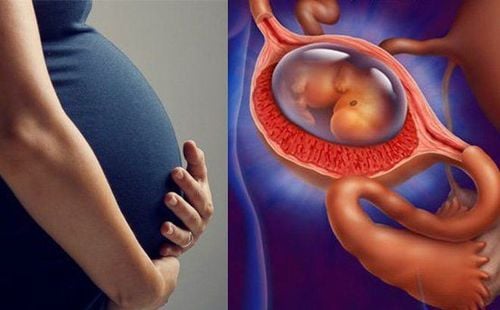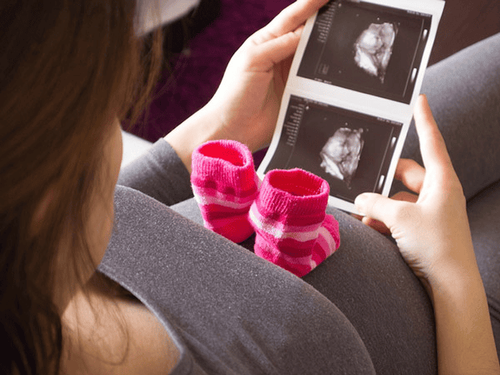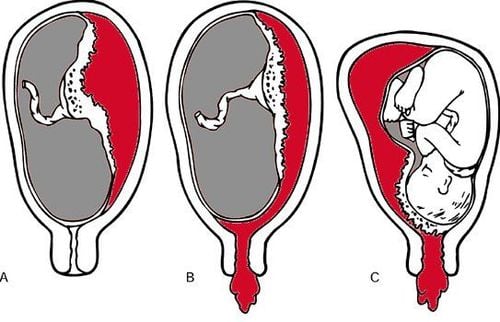This is an automatically translated article.
The article was professionally consulted by Dr. Nguyen Anh Tu - Doctor of Obstetric Ultrasound - Prenatal Diagnosis - Obstetrics Department - Vinmec Hai Phong International General Hospital.Polyhydramnios in the last weeks of pregnancy, the worry is the risk of premature birth due to the rapid growth of the mother's abdomen, affecting the tolerance of the cervix.
1. The role of amniotic fluid
Amniotic fluid is the fluid that surrounds the fetus, helps the fetus to avoid external collisions, participates in fetal metabolism, and also protects the mother from pain caused by baby kicks. The amount of amniotic fluid more or less is not good for both mother and fetus.
According to obstetricians, amniotic fluid acts as a cushion, it helps protect the fetus and helps the fetus develop. In the early stages, amniotic fluid is formed by permeation of maternal serum across the amniotic membrane, or permeation of fetal serum through fetal skin. In the later stages, from the time the fetus is 10 weeks old - 12 weeks old, amniotic fluid is formed by urine secreted from the kidneys and fluid from the lungs of the fetus.
When the fetus is 16 weeks to 32 weeks old, the amount of amniotic fluid reaches from 250ml - 800ml, then increases to 1,000ml and maintains until the fetus is 36 weeks old. Your doctor can calculate the amount of amniotic fluid with an ultrasound. From this point until the birth of the baby, the amount of amniotic fluid will gradually decrease and be about 500ml (at birth). Therefore, the closer the pregnancy is to the due date, the less amniotic fluid will be.

2. Polyhydramnios
Polyhydramnios is a condition in which too much amniotic fluid surrounds the fetus in the uterus. Amniotic fluid will begin to form around 12 days after conception. Its job is to support the fetus and help with the development of the limbs, lungs and digestive organs. It also helps to wrap and support the fetus to maintain a stable and appropriate body temperature.
The amount of amniotic fluid continues to increase steadily until around the 33rd week of pregnancy, from which point the trend begins to level off. With polyhydramnios, the amniotic sac contains an amount of water that exceeds the normal ideal of pregnancy. The average amount of amniotic fluid is usually around 800-1000ml (1 liter). When this volume exceeds two liters it becomes significant, especially for the mother, because then the discomfort also increases significantly. In fact, polyhydramnios occurs in about 3-4% of pregnancies.
In most cases, polyhydramnios is not a serious problem. The short period of time when fluid is produced out of synchrony as usual will soon stabilize again, and excess fluid will be reabsorbed by the mother's body.
3. What is the amniotic fluid like when the fetus is at 37 weeks?
When the fetus is in the 37th week of pregnancy, the maximum amount of amniotic fluid is approximately 1000ml. At this time, the fetus has grown, so the amniotic fluid will also become cloudy and colored like rice water. In addition, some mothers will notice sediment in the amniotic fluid during an ultrasound. This is a completely normal situation, so mothers do not need to be too worried.
In addition, some women this week will see a decrease in the amniotic fluid index. However, if the amniotic fluid drops below 60mm or increases above 120mm, the woman may need to be hospitalized for lack of amniotic fluid or polyhydramnios.
Cases where the amniotic fluid in the mother's abdomen is less than or more than normal, bringing many potential risks to the mother and the fetus. When the amniotic fluid is too much, it will cause many complications such as premature rupture of membranes, premature birth, overstretched amniotic sac that will cause placental abruption, abnormal fetal position, which can lead to cesarean section. The mother may also experience bleeding after giving birth.
Lack of amniotic fluid will limit fetal activity in the amniotic membrane. The fetus is malnourished, has growth retardation and is at risk of defects after birth. And the mother will be at risk of premature birth because of fetal distress.
4. Risk factors for polyhydramnios

Risk factors for polyhydramnios such as:
Having multiple pregnancies, due to the size of the placenta and the amount of space the fetus takes up in the uterus When the mother has diabetes during pregnancy and is not treated effectively When identical twins have the phenomenon of transmission, it is passed on to each other. This is a situation that arises when one fetus receives more blood flow than the other. In some cases, polyhydramnios often has no known cause.
5. Signs and symptoms of excess amniotic fluid during pregnancy
Signs and symptoms of polyhydramnios during pregnancy include:
Rapid and excessive weight gain, normal weight gain in a pregnancy is about 12 kg The size of the mother's abdomen increases rapidly and feels difficult bear. Fetus tends to reduce movement Shortness of breath Heartburn, indigestion and difficulty eating as much as usual The mother's abdomen is tight, difficult to feel and feel the baby's limbs inside. However, these are fairly common problems for pregnant women and may not be entirely caused by polyhydramnios. Therefore, mothers need to have tests and tests when having the above symptoms to determine exactly.
6. Risk of preterm birth with polyhydramnios in late pregnancy
If there is a lot of amniotic fluid, the mother may notice that the abdomen is expanding rapidly, the abdomen is tight and uncomfortable.
Effects of polyhydramnios on fetal development and health: If polyhydramnios is caused by malformations or malformations, the prognosis is very poor. Polyhydramnios will make the baby quite mobile in the uterus, so it is easy for the umbilical cord to wrap around the neck, abnormal position. Polyhydramnios causes the mother's abdomen to become larger than usual, especially acute polyhydramnios. Mothers find it difficult to breathe, are prone to uterine contractions, and premature labor increases the infant's mortality rate. During labor, polyhydramnios is easy to cause prolonged labor, making the baby more likely to fail, and the mother has uterine atony, causing postpartum hemorrhage. At the same time, polyhydramnios will lead to the risk of sudden rupture of membranes and the complications of sudden rupture of membranes are: placental abruption, umbilical cord prolapse, abnormal position and amniotic fluid embolism.
However, childbirth with polyhydramnios still takes place normally for pregnant women. You may have to give birth earlier than your due date due to changes in the uterus. Some women with severe polyhydramnios may also need to be induced earlier than usual. In addition, pregnant women can also be assigned to have a cesarean section if the fetus is abnormal such as: twin pregnancy, complicated fetal position or horizontal pregnancy...
But in general, if cared for and intervened in time , polyhydramnios does not endanger the life of the mother and the baby. If it is only mild, the mother's body can naturally adjust the amniotic fluid level during pregnancy and give birth to a healthy, normal baby.
7. Diagnosis of polyhydramnios

Diagnosis of polyhydramnios through clinical signs eg: when the size of the mother's abdomen is not suitable for the gestational age. The amount of amniotic fluid that surrounds the baby can be measured with the amniotic fluid index (AFI). Ultrasound will be able to give a clear picture of the amount of fluid and aid in the diagnosis of polyhydramnios if present. A normal AFI is between 8-18, an AFI greater than 20-24 indicates signs of polyhydramnios.
8. Treatment of polyhydramnios
There is no specific treatment other than close monitoring of the mother. If the amount of amniotic fluid becomes excessive and there is a high risk of preterm birth, then amniocentesis is done to remove the excess fluid. This procedure must be supervised, and performed by a trained obstetrician. An ultrasound is usually done at the same time to make sure there is no risk to the baby, the umbilical cord, or the placenta.
Another treatment is to take medication that reduces the production of amniotic fluid. However, this method is not indicated after 32 weeks of pregnancy because it can cause potential problems.
Lack of amniotic fluid or polyhydramnios seriously affects the health of the fetus and pregnant mother. Therefore, regular prenatal check-ups are extremely important during pregnancy. Regular check-ups and accurate diagnosis and advice from a doctor will help detect early signs of abnormalities in the fetus.
At the Department of Obstetrics and Gynecology - Vinmec International General Hospital, many difficult cases have been solved such as: Polyhydramnios, placenta accreta, knotted umbilical cord, preterm pregnancy... To make the pregnancy process more convenient, Vinmec has deployed PACKAGE Maternity packages, including prenatal, intrapartum and postpartum care services. Pregnant women are monitored and carried out all necessary tests and ultrasounds to detect pregnancy abnormalities early. The birth will be "gentle" like going on vacation, at the hospital, there are fully equipped for mother and baby.
Doctor Nguyen Anh Tu has 6 years of experience in obstetrics and gynecology ultrasound, specially researched and trained in pregnancy ultrasound - prenatal diagnosis. Dr. Tu has completed courses on ultrasound - prenatal diagnosis of the FMF International Fetal Medicine Association; trained in consulting and implementing diagnostic intervention techniques in fetal medicine and participated in many specialized conferences and seminars on Fetal Medicine. Currently, he is a doctor at the Department of Obstetrics and Gynecology, Vinmec Hai Phong International General Hospital.
Please dial HOTLINE for more information or register for an appointment HERE. Download MyVinmec app to make appointments faster and to manage your bookings easily.














